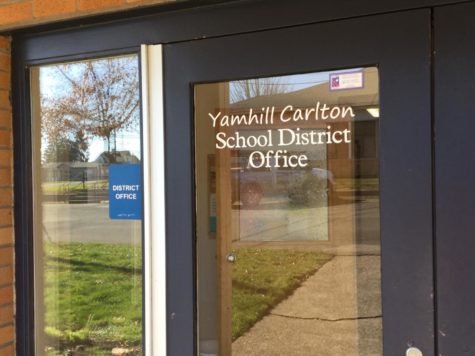Where does the money go? School officials explain how the school budget works
There are many misconceptions on how school funding at Yamhill-Carlton School District works, from believing all the sport funds go to football, to thinking clubs get money of their own. Here is the truth about Yamhill-Carlton’s school funding.

The district receives most of its money from the state. It’s called the State School Fund and they budget this for a biennium, or two years. The State budget is made up of payroll taxes, Oregon lottery, and property taxes to name a few. The state fund is about 85% of the district’s general fund.
The amount of money each school district gets is accounted for by how many students are in the school district, this is called the ADM or the Average Daily Membership.
YC’s business manager, Tami Zigler says, ”From the state’s funding YC receives approximately .174% of the total State School Fund. For every $100 million increase from the state, YC receives an additional $75,000.
Every two years the amount of money that comes into the school changes, it can either increase or decrease.”
If one of the district’s yearly payments to the school district has several families leave, that doesn’t mean that the next time our funding will go down. The state gives the district funding based on the higher of the two years of ADMw.
Every month Yamhill county sends the school district money from taxes, in addition payments are received from the common school fund. For every county, the common school fund taxes that go to schools get divided by ADM. Zigler always says, “Don’t underestimate taxes!”
The state also funds schools more money if they have ESL students, or students with special needs because they might need aids, or teachers who specifically teach English, this costs more so the state has to give schools more money for that. This is called the ADMw or “weighted” formula.
YC High School Principal Steve Cooper explains how dividing the school money works.
He said, “We’ll find out what our lump is, and then we allocate those funds into different categories. And those categories can be everything from textbooks and supplies to locker repairs to training for teachers. And so we’ll kind of take a look and see where, what money we spent this year, and what our needs were. And for example, if we spent all of our math money, and we were short, then for the budget for next year, we might add 10% or add money too as we haven’t used this category of money in two years.”
Cooper also said, “Every two years the school looks at how much money each sport is going to need and distributes the money that way. Jerseys for teams are on a cycle, so every time they might get new jerseys every 3-5 years, unless they want new jerseys then they can fund raise and make money for new ones.”
The biggest misconception about sports and school funding is football. It may seem that all of our sports funding goes straight to the football team, but it doesn’t. The football team receives more money, because they need to pay for referees and their traveling costs. Football uniforms are the most expensive, and they travel more than most sports.
Zigler said, “Other ways the district receives money is through grants, the district has two main revenue, the first one is the High Cost Disability Grant, where the district receives an average of $30,000 from the state, and the Small School Grant, where the district receives approximately $50,000.”
The percent used on everyday items, including materials, and supplies, only makes up 3% of the district’s overall budget, 3% goes to property insurance, and another 3% goes to transfers to pay off debt. Overall salaries and benefits make up 73% of the entire budget. 51% of the budget goes to instruction, which is teachers’ pay, substitute costs, curriculum, and supplies. 38% of the budget is support services, which is maintenance, transportation, principal, and the office. The instruction budget of 51%, salaries and benefits make up 68%, 37% of that goes towards medical insurance, payroll taxes, and retirement. Not all of that 51% goes to the teachers salary.
There are many misconceptions about school funding, from money transfers to sport traveling, but the best thing to understand is the school district knows what they’re doing, and has the students’ best interests at heart.
